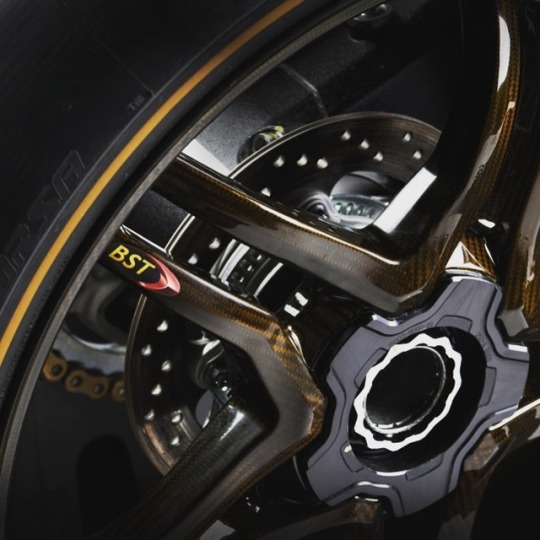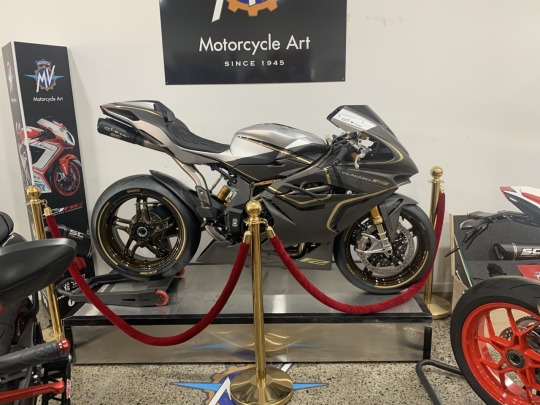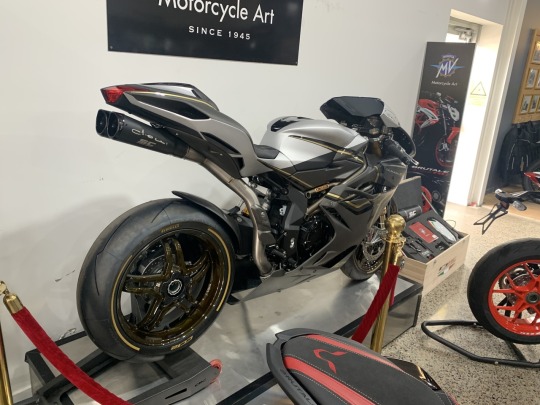#f4 claudio
Explore tagged Tumblr posts
Text





MV Agusta F4 1000 « Claudio Castiglioni », série spéciale construite à seulement 100 exemplaires. - source Ruote da Sogno
19 notes
·
View notes
Text
Check Out the MV Agusta F3 Competizione
The MV Agusta F3 Competizione is a sportbike lover’s dream, dripping in satin black, silver, and gold – a nod to its F4 Claudio inspiration. Limited to just 300 units, each model is individually numbered and comes with a certificate of authenticity. Continue reading Check Out the MV Agusta F3 Competizione
0 notes
Text
MV Agusta Senna: La moto que le rindió homenaje al gran Ayrton Senna
En 2002 y 2006 la legendaria marca lanzó ediciones especiales basadas sobre su superbike insignia en ese momento.
El brasileño Ayrton Senna, el legendario campeón de Fórmula 1, no solo dejó una huella imborrable en el mundo del automovilismo, sino que también inspiró creaciones excepcionales más allá de las pistas. En 2002, MV Agusta, bajo la dirección de Claudio Castiglioni, presentó la F4 750 Senna, una obra maestra de la ingeniería y el diseño motociclista. El magnate italiano de las motocicletas había…

View On WordPress
0 notes
Photo

In 2019, They, will fear, YOU.
#New Year's Day#2 Wheel Tuesday#Italian Beauty#moto#F4 Claudio#MV Agusta#sport bike#motorcycle#bike stand#liter bike
38 notes
·
View notes
Text
Hay motos que sabes que te van a conquistar incluso antes de verlas. Y eso fue justo lo que nos pasó cuando nos llegó el comunicado de prensa de la nueva MV Agusta F4 Claudio. Una moto con la que la firma de Varese le rinde un homenaje al hombre que hizo posible esta máquina contra todo pronóstico: Claudio Castiglioni. Por eso, en cuanto vimos que la más reciente F4 llevaba el nombre de su “padre”, supimos que tenía que tratarse de algo muy especial.
Si no seguías muy de cerca el mundo del motociclismo a finales de los noventa, tal vez no sepas que -tras su presentación en el EICMA de 1997-, muchísima gente dudó que la MV Agusta F4 viera la luz. Simplemente, pensaban que la firma de Varese no tenía ni el conocimiento técnico ni el dinero para llevar a cabo una idea sumamente ambiciosa: crear una moto de calle que se sintiera como una de las 500 cc que en aquel entonces competían en MotoGP.
De hecho, no fue sino hasta un par de años después, en 1999, cuando la F4 llegó a las calles con un carenado espectacular, creación de Massimo Tamburini, y unas prestaciones de infarto, como una velocidad punta de más de 265 km/h. En pocas palabras, se trataba de una máquina como ninguna otra; una moto que representaba la materialización del sueño de uno de los grandes del motociclismo y que marcó un antes y un después para las motos deportivas. Ahora, a siete años del fallecimiento de Castiglioni, la firma de Varese le rinde un merecidísimo homenaje con la MV Agusta F4 Claudio.
Pura sangre
Sabes que la cosa va en serio cuando la máquina en la que está basada es la F4 RC, la cual fue desarrollada en paralelo con la que compite en el Mundial de Superbike. Cuando la MV Agusta F4 Claudio está configurada para la pista, la potencia es de 212 HP a 13,450 rpm y el torque alcanza las 85 lb-pie a 9,500 vueltas; pero si quieres rodar por la calle, tendrás que conformarte con “solo” 205 HP. Del sonido en la pista se encarga un impresionante sistema de escape dual de titanio firmado por SC-Project, el cual no se puede usar en la calle (al menos en Europa, seguro que aquí les da igual).
La electrónica de la MV Agusta F4 Claudio viene directamente de la que se ha desarrollado para el Mundial de SBK. Hay cuatro mapas para el motor, los cuales puedes elegir instantáneamente usando unos botones desarrollados exclusivamente para esta moto. A los modos de manejo Normal, Sport y Rain le sumaron uno Custom en el que puedes personalizar a tu gusto parámetros como la respuesta del acelerador o el freno del motor. También hay un control de tracción de ocho niveles que promete funcionar en cualquier condición, desde la pista más mojada y resbaladiza hasta una donde la moto se agarra como político al hueso.
Otra característica de la MV Agusta F4 Claudio es un panel de instrumentos AIM con adquisición de datos y GPS integrado que permite monitorear el comportamiento dinámico de la moto, especialmente en la pista, para saber qué estás haciendo en cada momento. Esta moto es una verdadera sílfide, pues cuando está más pesada, la báscula marca 183 kilos, pero cuando entras a la pista con el escape de titanio, la F4 Claudio pesa solo 175 kilos.
Solo lo mejor
La elección de materiales para la MV Agusta F4 Claudio es impresionante, pues encontramos titanio, fibra de carbono y aleaciones ligeras que mantienen bajo el peso. Todo el carenado está hecho en fibra de carbono, con un patrón que alterna zonas brillantes con mates. El cual, no está de más decirlo, es casi tan sexy como Monica Bellucci. Vamos que incluso las salpicaderas, el asiento del pasajero y los rines BST están fabricados en este ligero material. Para la tornillería usaron titanio y para la mayoría de los elementos funcionales, como los posapies o las manijas, escogieron aluminio mecanizado.
En cuanto a los frenos, en el eje delantero utiliza lo mejor que tiene Brembo en sistemas de cuatro pistones con los calipers Stylema (que también monta la Ducati Panigale V4) y dos discos de 320mm. Atrás hay un disco de 210mm, ahora con caliper Nissin, pero también de cuatro pistones. El ABS es Bosch 9 Plus, lo cual quiere decir que hay un modo de carreras y función anti-caballito.
La suspensión Öhlins también es de lo mejor, por supuesto, y una horquilla invertida delantera de 43mm con ajuste separado de compresión (izquierda) y rebote (derecha), la cual también se puede ajustar en precarga, claro. Esto también aplica para el monoamortiguador TTX36 con depósito de reserva que se encarga de absorber las irregularidades del camino para el eje trasero.
Las llantas de la MV Agusta F4 Claudio no son cualquier cosa, obviamente, sino unas Pirelli Diablo Supercorsa en medidas 120/70 ZR17 al frente y 200/55 ZR17 atrás que llevan unas líneas doradas en los costados, una solución exclusiva para esta moto que hace juego con los vivos en ese color que hay en el carenado.
Como seguramente ya les ha quedado claro, en la firma de Varese son fans de las ediciones limitadas (Lewis Hamilton sabe algo al respecto) y, obviamente, la MV Agusta F4 Claudio no es la excepción. Se construirán solamente 100 unidades y cada una tendrá un precio de 1,8500,000 pesos. ¿Elevado? Sin duda, pero no solo se trata de la moto con la MV Agusta rinde homenaje a Claudio Castiglioni, también es con la que despiden la producción de la F4.
Especificaciones
Motor 4 cil, 998cc, enfriado por líquido Potencia 212/205 HP y 85 lb-pie Transmisión 6 velocidades, por cadena Suspensión Öhlins, horquilla invertida y monoamortiguador Tanque 17 litros
MV Agusta F4 Claudio, la última y nos vamos Hay motos que sabes que te van a conquistar incluso antes de verlas. Y eso fue justo lo que nos pasó cuando nos llegó el comunicado de prensa de la nueva…
1 note
·
View note
Photo



2019 MV Agusta F4 CLAUDIO, http://www.daidegasforum.com/forum/forum-specifici-di-marca/mv-agusta/foto-e-video-af/10410948-mv-agusta-f4-claudio
#mv f4 claudio#mv agusta#mv agusta f4#daidegas#bst#brembo#moto#motorbike#motorcyle#bikeporn#mv agusta f4claudio#mv agusta f4 claudio
22 notes
·
View notes
Photo

When MV Agusta closed its doors in 1977 it signalled the death of Italy’s premier motorcycle brand. Between 1952 and 1976 MV won 37 world titles and took 270 Grand Prix victories, an achievement unmatched at the time. In 1978 Claudio and Gianfranco Castiglioni of Cagiva took steps to acquire the MV name but these talks broke down. The factory was dismantled soon afterwards and in 1982 the company was placed into liquidation.
Things move slowly in Italy and it wasn’t until a decade later, in the spring of 1992, that the Castiglionis finally managed to acquire MV Agusta. At the time the Castiglioni’s owned Cagiva, Ducati, Morini and Husqvarna, and operated out of the old AMF-Harley-Davidson Aermacchi premises at Schrianna on shore of Lake Varese. Massimo Tamburini ran Cagiva’s design department, CRC (Cagiva Research Centre), situated in San Marino. Tamburini came to Cagiva from Bimota (the “Ta” in Bimota), and by late 1992 was in the final stages of finishing the Ducati 916. But after the 916 was finished Tamburini was ill with a stomach tumour and it wasn’t until 1995 that he could embark on the next production bike project; the four-cylinder F4.
Andrea Goggi, an engineer with Cagiva since 1988, was entrusted with redesigning the liquid-cooled F4 engine. With oversquare dimensions of 73.8x43.8mm and a central chain-drive for the double overhead camshafts, the layout was unlike the Japanese four-cylinder engines at the time that featured side cam chain drives. The cylinder block was sand-cast as a separate entity, and inclined forward 20 degrees. This provided near vertical 46mm throttle bodies for the Weber-Marelli electronic fuel injection. Another unusual feature was a reduction gear driven off the crankshaft that allowed smaller cam sprockets. This reduced the size of the cambox but the cams rotated backwards and required a front-mounted cam chain tensioner. A unique feature was the radial four-valve per cylinder layout. The included valve angle was a narrow 22-degrees, with the valves tilted outwards 2-degrees. The cassette-style six-speed gearbox came from the 500cc Cagiva Grand Prix racer, the primary drive was by straight-cut gears and the clutch a wet multiplate. Tamburini designed the 4-2-1-2-4 exhaust system, with special emphasis on the four rear exhaust pipes. He wanted it to sound like music. “It looks like organ pipes. Just like I love listening to Pavarotti, I love listening to the engine,” Tamburini said. The pistons provided a 12:1 compression ratio and the 749.4cc four-cylinder engine produced 126 horsepower at 12,200rpm.
Eschewing the popular aluminium beam frame, Tamburini preferred a composite chassis layout. This included chrome-molybdenum tubular steel upper section wrapping around the narrow engine and bolting to cast magnesium rear uprights. These doubled as an engine cradle and pivots for the single-sided magnesium swingarm. Eccentrics on the steering head bearings provided adjustable steering geometry, while alternative mounts for the Sachs shock absorber allowed a choice of rising-rate.
The suspension, wheels and brakes were all designed specifically for the F4. The 49mm upside down Showa fork incorporated quick release axle clamps and the brakes were designed in cooperation with Nissin. Along with 310mm floating discs, the front calipers featured six pistons of different diameter. At the rear was a 210mm disc with four-piston caliper. Marvic supplied the magnesium 3.50x17 and 6.00x17-inch wheels and Tamburini commissioned Pirelli supply a special 120/65ZR17 EVO front tyre to match the 190/50ZR17 rear. Completing a rigid chassis specification were large diameter axles, 35mm on the front and 50mm on the rear.
The F4’s styling was another Tamburini triumph. Following the example set by the Ducati 916, the small poly-ellipsoidal headlights dominated the frontal aspect. The final design placed the twin headlights one above another in the centre of the fairing. According to Tamburini, “Lights in the centre are easier to control, allow a more compact fairing and simplify homologation around the world.” Completing the specification of the 184kg F4 750 Oro was carbon-fibre bodywork, a transverse Öhlins steering damper and adjustable (by eccentrics) footpegs and levers. Instrumentation was thoroughly modern, with a digital speedometer and analogue tachometer. Rolling on a short 1,398mm wheelbase the F4 750 Oro promised exceptional agility and stability, with a claimed top speed of 275 km/h.
The F4 Oro was initially unveiled at the Milan Show in September 1997, and appeared in the Guggenheim exhibition The Art of the Motorcycle at the end of 1998. Production of three a day commenced mid-1999 and by the end the year delivery of the limited edition run of the 300 pre-ordered examples was complete. Unfortunately, as it took so long to develop by the time the F4 Oro was released it was arguably already obsolete. By 1999 the Japanese 750 fours were lighter and more powerful. But that didn’t worry prospective F4 Oro buyers, most who would never ride them. Many Oros went into the collections of celebrities, including King Juan Carlos of Spain, Jay Leno, Giacomo Agostini, and Max Biaggi. And while MV Agusta has released many limited editions since 1999, the F4 750 Oro stands alone. The F4 Oro heralded MV Agusta’s resurrection and is still the most collectable of the new generation MV Agustas.
16 notes
·
View notes
Photo

For Details : 2019 MV Agusta F4 Claudio --
1 note
·
View note
Photo

“Eva”, tecnica mista su carta Fabriano F4 200 g/mq, cm. 33 x 48, firmato, con timbro e certificato d’autenticità sul retro www.claudiopavone.it «“Eva” è un’opera grafica di eccezionale gradevolezza! I tratti fini e nervosi, la misurata colorazione, l’espressività e la penetrazione psicologica accompagnata all’estrema sobrietà dei mezzi impiegati, fanno di quest’opera del pittore Claudio Pavone un vero e proprio piccolo capolavoro. Una sorta di provocazione densa d’ironia... In quest’opera il pittore Claudio Pavone dona infatti un saggio della propria raffinatezza e sensibilità stilistica, che sboccia in questo piccolo grande pezzo da collezione!» (M.L.) (presso Pioltello, Lombardia, Italy) https://www.instagram.com/p/CkjBdstLroJ/?igshid=NGJjMDIxMWI=
0 notes
Photo

MV Agusta F4 Claudio #mvagustaf4 #mvagusta #tamburini #varese #italiandesign #twowheels #wheels #dark #carbonfiber #carbonfibre https://www.instagram.com/p/BpJ2-PLFAcB/?utm_source=ig_tumblr_share&igshid=1dy26zqknk3uj
6 notes
·
View notes
Photo

October 22, 2018 at 09:19PM Feast Your Eyes On The 2019 MV Agusta F4 Claudio https://www.itsabikerslife.com/2018/10/feast-your-eyes-on-2019-mv-agusta-f4.html
3 notes
·
View notes
Photo

MV Agusta F4 Claudio - the ultimate F4.

Everybody knows that the folks at MV Agusta are very attached to their famous F4 and for the people behind the brand. So the company came up with a limited edition series that might be the sexist superbike they’ve ever released. Unfortunately, only 100 units of the MV Agusta F4... Read more on our website.
2 notes
·
View notes
Photo

Kit montaggio Serbatoio Olio Pompa Freno Brembo Radiale ed RCS MV AGUSTA F4 CLAUDIO CASTIGLIONI 1078 2007 • Brembo Racing • 46,26 € • 110A26385 • https://www.sixrace.it/it/accessori-freno/106296-kit-montaggio-serbatoio-olio-pompa-freno-brembo-radiale-ed-rcs-mv-agusta-f4-claudio-castiglioni-1078-2007.html
0 notes
Photo

No need to have much weight here.
#Pirelli#carbon fiber#Moto#MV Agusta#F4 Claudio#sport bike#Wednesday's wheel#motorcycle#Italian Beauty
70 notes
·
View notes
Photo





MV Agusta F4 CLAUDIO, http://www.daidegasforum.com/forum/forum-specifici-di-marca/mv-agusta/foto-e-video-af/10410948-mv-agusta-f4-claudio
#mv agusta#mv f4#mv f4 claudio#mv agusta f4 claudio#claudio castiglioni#moto#motorbike#motorcycle#daidegas
17 notes
·
View notes
Text




I decided to look at some bikes and come across this pretty piece of machinery. 125,100 AUD or 80,000 USD
1000CC MV Agusta F3/F4 Reparto Corse review:
• A carbon fibre fairing with alternate gloss and matt-finish patterning;
• Carbon BST Rapid Teck wheels
• Laser-engraved, dual-exit titanium SC-Project racing exhaust
• World superbike-spec left and right racing-type push-buttons;
• Full colour AIM dash with data acquisition, integrated GPS exclusively customised with dedicated graphics;
• Cross-stitched rider seat with embroidered Claudio logo; and
• O¨hlins USD NIX 30 forks & O¨hlins TTX36 shock absorber.
MV Agusta F3/F4 Reparto Corse 212 hp at 13,600 rpm, with 85 pound-feet torque peaking at 9,300 rpm, more than 4,000 rpm below maximum power peak. The MV Agusta F4 Claudio engine compression ratio is 13.4:1 and features variable geometry throttle bodies. Each cylinder is fed by two injectors: four Mitsubishis down the inlet port and four high-capacity Magneti Marellis in the overhead “shower” position.
0 notes